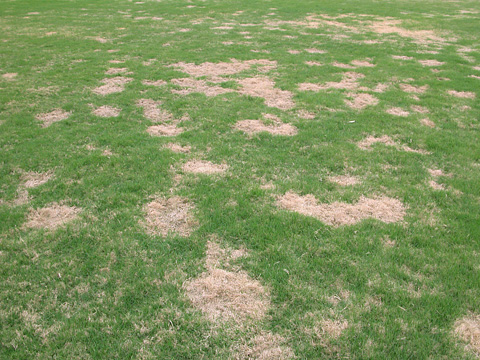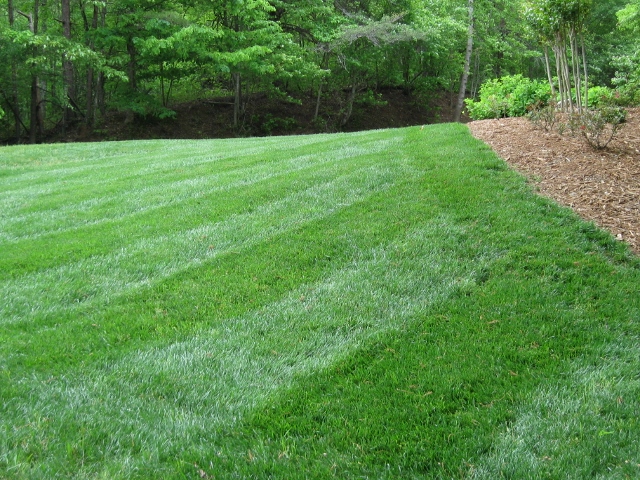|
|
BermudaSpring Dead SpotThe recommendation to help control Spring Dead Spot is to treat the turf in the fall with a fungicide when the disease is active. The goal is to decrease the presence of disease with fall fungicide applications. Two treatments are required during the fall season and timing is determined by soil temperature. We have seen the disease disappear after several seasons of treatment. There is no quick fix for Spring Dead Spot. Aeration, as many as three times during the growing season, has proven to be beneficial. The first application of fungicide to treat Spring Dead Spot needs to be applied during September and the second should follow later in the fall. Turf grass researchers emphasize not to expect control in the first year but fungicide treatments in combination with proper cultural practices will gradually decrease disease and complete control may eventually be achieved. Posted: September 11th, 2014 | Permalink Summer Lawn Care in the SouthAs soon as things begin to warm up in spring, it doesn’t take long for things to really heat up. Summer time in the South is long, hot and dry and this can take a toll on your landscaping.With some extra care and maintenance, it’s still possible to keep your lawn looking green and beautiful year-round. Here are a few tips to help your lawn withstand the heat this summer. Mowing Bermuda and Zoysia are good warm weather turfs and do great in the South. Properly mowing these turfs is a primary concern during the long summer months. Warm season turf should be mowed at a 1-to-2-inch mowing height. Keep in mind that mower blades should be sharpened frequently to achieve a quality cut. It is important to note that Fescue, a cool-season turf, does not grow much during the summer. Areas with this type of turf will naturally look thin due to the summer heat, and will not require a great deal of maintenance. Weed Control The use of post-emergent herbicides to kill those unwanted weeds, such as nutsedge, dallisgrass and crabgrass, will keep your lawn looking beautiful all summer long. Apply these weed control products at the beginning and end of each summer to delay their return. Aeration of Bermuda Like in the spring, aeration should be performed on Bermuda lawns again in the summer. Aeration reduces soil compaction commonly caused by foot traffic and mowing, improves the soil’s ability to accept nutrients provided by fertilizer and improves the decomposition of grass clippings and thatch. Fertilization and Mulching It’s important to apply a slow-release fertilizer on Bermuda and Zoysia during the summer growing season. The nutrients in the fertilizer will enhance turf color and help it withstand the high temperatures. Freshen up your plant beds by adding pine straw for a more finished look. Insect and Disease Inspection The spread of insects and diseases can quickly damage plant foliage. You should routinely inspect plants and turf for signs of insect infestation as well as irregularities in color, which is often a sign of disease. A common disease we come across in the summer is Brown Patch which is often associated with Fescue turf. Other Garden Tasks In addition to the tasks above, there are a few regular garden tasks that should be performed each week. These include, watering, trimming and pruning shrubs as needed and the removal of spent blooms from annuals to keep them from blooming throughout the summer months. Need help protecting your lawn this summer? Request a quote from the experts at Landscape Management Company! Posted: May 23rd, 2014 | Permalink Spring Lawn Care in the SouthAdditionally, the right planting and maintenance tasks will also vary depending on the season. Here, we will outline how to choose the right turf for the South and how to care for your lawn and plants during the spring season. Turf Choosing the right turf is very important to make sure that you have grass that will survive the temperature and climate during the summer months ahead. The southern area of the country is located within the “turf transition zone.” This means that the climate allows the use of both cool season (Fescue) and warm season (Bermuda/Zoysia) grasses. However, because weather conditions can fluctuate to extremes, all turf grasses are susceptible to environmental stresses. Fescue Fescue performs and looks its best in spring and fall. Fescue lawns will naturally thin as a result of summer heat and other environmental stress so expect to see this in the summertime. Bermuda and Zoysia Bermuda and Zoysia perform and look best in late spring through early fall. These grasses are completely dormant in the winter and lose all chlorophyll which results in the turf turning a light brown color. However, they fare very well during the harsh summer months making them a good pick for southern landscapes. Spring Turf Care When it comes to spring turf care, it’s important that all winter landscape tasks are finished before the spring. Be sure to make sure that you take into consideration what tasks need to be done during the fall and winter to prepare for spring. Let’s talk about what maintenance jobs actually need to be completed during the spring season. Here are several tasks that will need to be completed. Mowing Fescue performs and grows well in the spring and should be mowed weekly at a three to four inch mowing height. This height encourages a deep root system which helps to strengthen grass. In mid to late April, you will generally start to see the warm season grasses, Bermuda and Zoysia, begin to change back from brown to green as they transition out of their winter, dormant season. This is called “greening up.” These warm season lawns should be mowed weekly and at a one to two inch mowing height during late spring and summer. Scalping Scalping is a mowing process that is done primarily on Bermuda lawns in early to mid-spring or just before the Bermuda grass starts to green up. It involves the removal of excess, dead turf leaf matter to promote grass greening up sooner by allowing sunlight to warm the soil surface. Scalping also helps to prevent thatch and is done after all chance of frost is past. Core Aeration Another spring maintenance task on warm season turf is core aeration. Aeration is performed by coring type aerators that penetrate the soil surface and remove and redeposit small columns of soil. Aeration reduces soil compaction (caused by foot traffic, mowers, etc.); improves the soil’s ability to accept oxygen, water and nutrients provided by fertilizer; enhances decomposition of grass clippings and thatch that accumulate at the soil surface. Fertilization and weed control In early spring, it’s important to apply a slow release fertilizer to fescue turf. The same should be done to warm season grasses (Bermuda and Zoysia) in late spring. All turf grasses should be treated with a weed controller in the spring as well. Landscape Service Needs All the previously mentioned landscape maintenance tasks are specific to turf care. The following are some plant maintenance tasks that should be completed during spring. Disease and Insects You should always make it a point to inspect plants for disease or insect problems such as fire ants. Check the color and condition of the leaves and the soil surrounding the plant to make sure you don’t spot any irregularities in color or any insects. Spring and Summer Flowers Mid April is the perfect time in the South to add some spring color to your lawn with spring and summer flowers. Plan your selection carefully around the most summer hardy flowers. These will perform the best and endure the drought, heat and humidity stresses of southern summers. Trees and Shrubs Early spring is a good time for installing landscape plants such as trees, shrubs and perennials. However, there needs to be sufficient watering to get these plants through the dry summer months. It's also important to to prune and maintain the plants you install. Some trees may do better installed in the fall or winter so be sure to research the type of tree you are wanting to plant to see when is the best planting season. To learn more about the services that Landscape Management Company in offers in North Georgia, please contact us today! Posted: March 20th, 2014 | Permalink |




